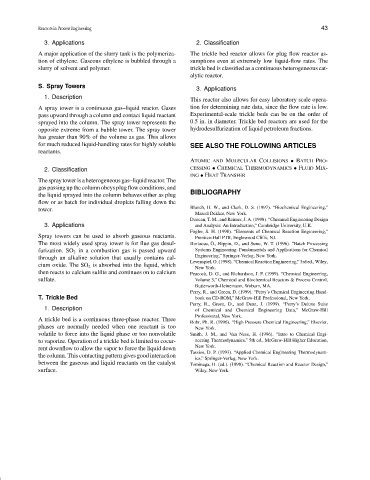Page 481 - Academic Press Encyclopedia of Physical Science and Technology 3rd Chemical Engineering
P. 481
P1: GNH/GUR P2: GPJ Final Pages
Encyclopedia of Physical Science and Technology EN014A-654 July 28, 2001 16:35
Reactors in Process Engineering 43
3. Applications 2. Classification
A major application of the slurry tank is the polymeriza- The trickle bed reactor allows for plug flow reactor as-
tion of ethylene. Gaseous ethylene is bubbled through a sumptions even at extremely low liquid-flow rates. The
slurry of solvent and polymer. trickle bed is classified as a continuous heterogeneous cat-
alytic reactor.
S. Spray Towers
3. Applications
1. Description
This reactor also allows for easy laboratory scale opera-
A spray tower is a continuous gas–liquid reactor. Gases tion for determining rate data, since the flow rate is low.
pass upward through a column and contact liquid reactant Experimental-scale trickle beds can be on the order of
sprayed into the column. The spray tower represents the 0.5 in. in diameter. Trickle bed reactors are used for the
opposite extreme from a bubble tower. The spray tower hydrodesulfurization of liquid petroleum fractions.
has greater than 90% of the volume as gas. This allows
for much reduced liquid-handling rates for highly soluble SEE ALSO THE FOLLOWING ARTICLES
reactants.
ATOMIC AND MOLECULAR COLLISIONS • BATCH PRO-
2. Classification CESSING • CHEMICAL THERMODYNAMICS • FLUID MIX-
ING • HEAT TRANSFER
The spray tower is a heterogeneous gas–liquid reactor. The
gas passing up the column obeys plug flow conditions, and
the liquid sprayed into the column behaves either as plug BIBLIOGRAPHY
flow or as batch for individual droplets falling down the
tower. Blanch, H. W., and Clark, D. S. (1997). “Biochemical Engineering,”
Marcel Dekker, New York.
Duncan, T. M., and Reimer, J. A. (1998). “Chemical Engineering Design
3. Applications and Analysis: An Introduction,” Cambridge University, U.K.
Fogler, S. H. (1998). “Elements of Chemical Reaction Engineering,”
Spray towers can be used to absorb gaseous reactants. Prentice-Hall PTR, Englewood Cliffs, NJ.
The most widely used spray tower is for flue gas desul- Hortacsu, ¨ O., Rippin, D., and Suno, W. T. (1996). “Batch Processing
furization. SO 2 in a combustion gas is passed upward Systems Engineering: Fundamentals and Applications for Chemical
through an alkaline solution that usually contains cal- Engineering,” Springer-Verlag, New York.
Levenspiel, O. (1998). “Chemical Reaction Engineering,” 3rd ed., Wiley,
cium oxide. The SO 2 is absorbed into the liquid, which
New York.
then reacts to calcium sulfite and continues on to calcium Peacock, D. G., and Richardson, J. F. (1999). “Chemical Engineering,
sulfate. Volume 3,” Chemical and Biochemical Reactors & Process Control,
Butterworth-Heinemann, Woburn, MA.
Perry, R., and Green, D. (1999). “Perry’s Chemical Engineering Hand-
T. Trickle Bed book on CD-ROM,” McGraw-Hill Professional, New York.
Perry, R., Green, D., and Dean, J. (1999). “Perry’s Deluxe Suite
1. Description of Chemical and Chemical Engineering Data,” McGraw-Hill
Professional, New York.
A trickle bed is a continuous three-phase reactor. Three
Rohr, Ph. R. (1996). “High Pressure Chemical Engineering,” Elsevier,
phases are normally needed when one reactant is too New York.
volatile to force into the liquid phase or too nonvolatile Smith, J. M., and Van Ness, H. (1996). “Intro to Chemical Engi-
to vaporize. Operation of a trickle bed is limited to cocur- neering Thermodynamics,” 5th ed., McGraw-Hill Higher Education,
rent downflow to allow the vapor to force the liquid down New York.
Tassios, D. P. (1993). “Applied Chemical Engineering Thermodynam-
the column. This contacting pattern gives good interaction
ics,” Springer-Verlag, New York.
between the gaseous and liquid reactants on the catalyst Tominaga, H. (ed.). (1998). “Chemical Reaction and Reactor Design,”
surface. Wiley, New York.

